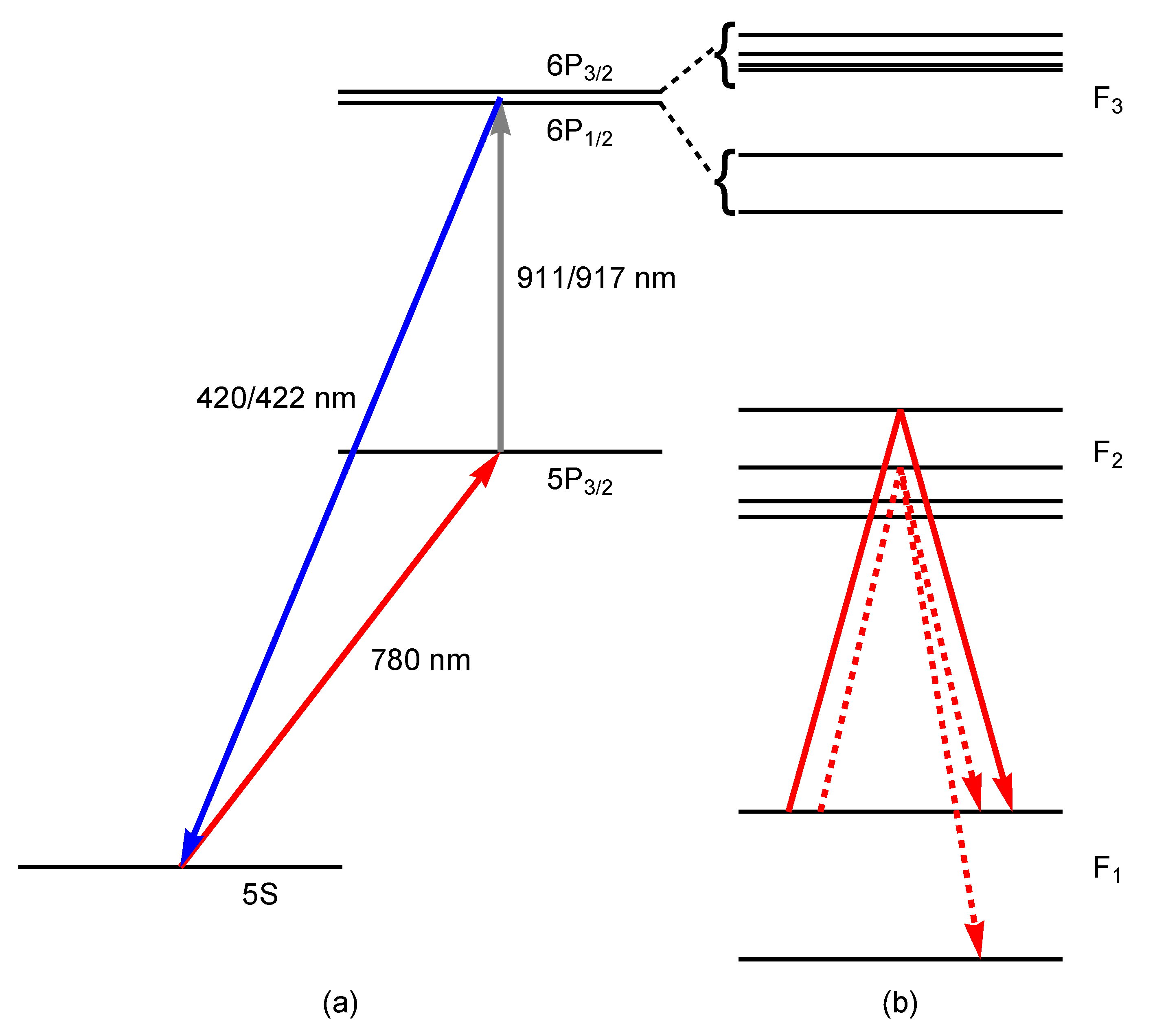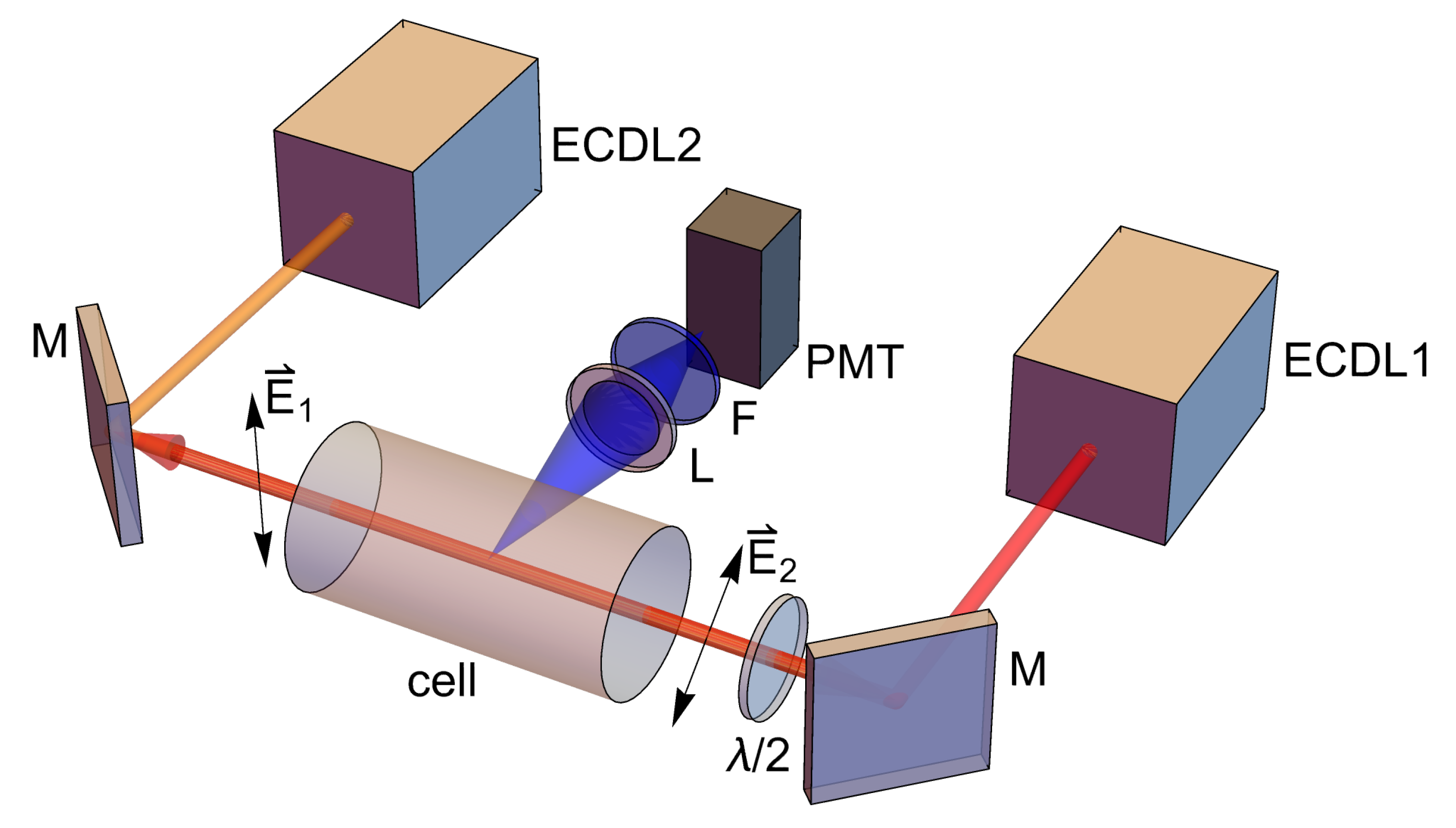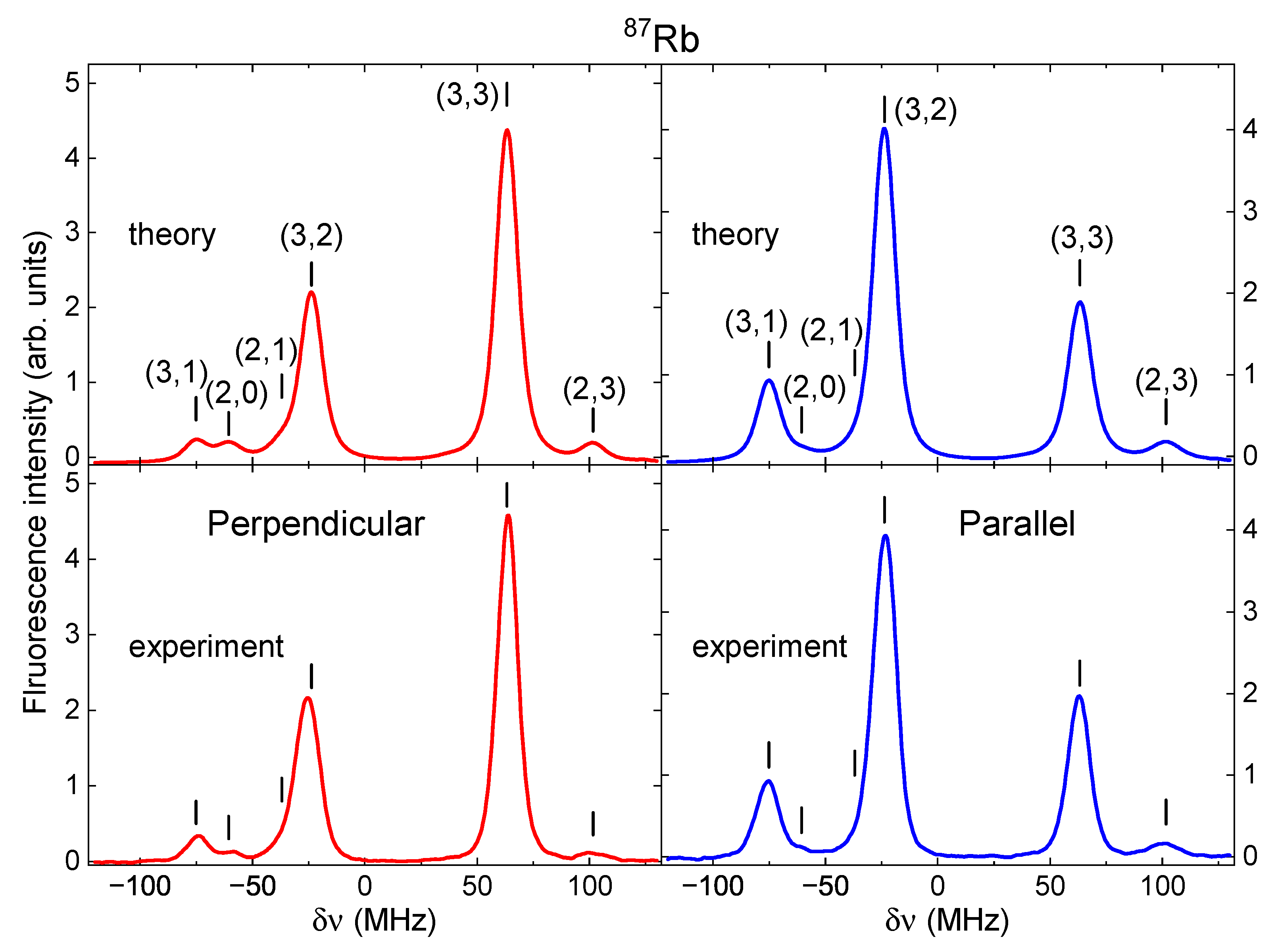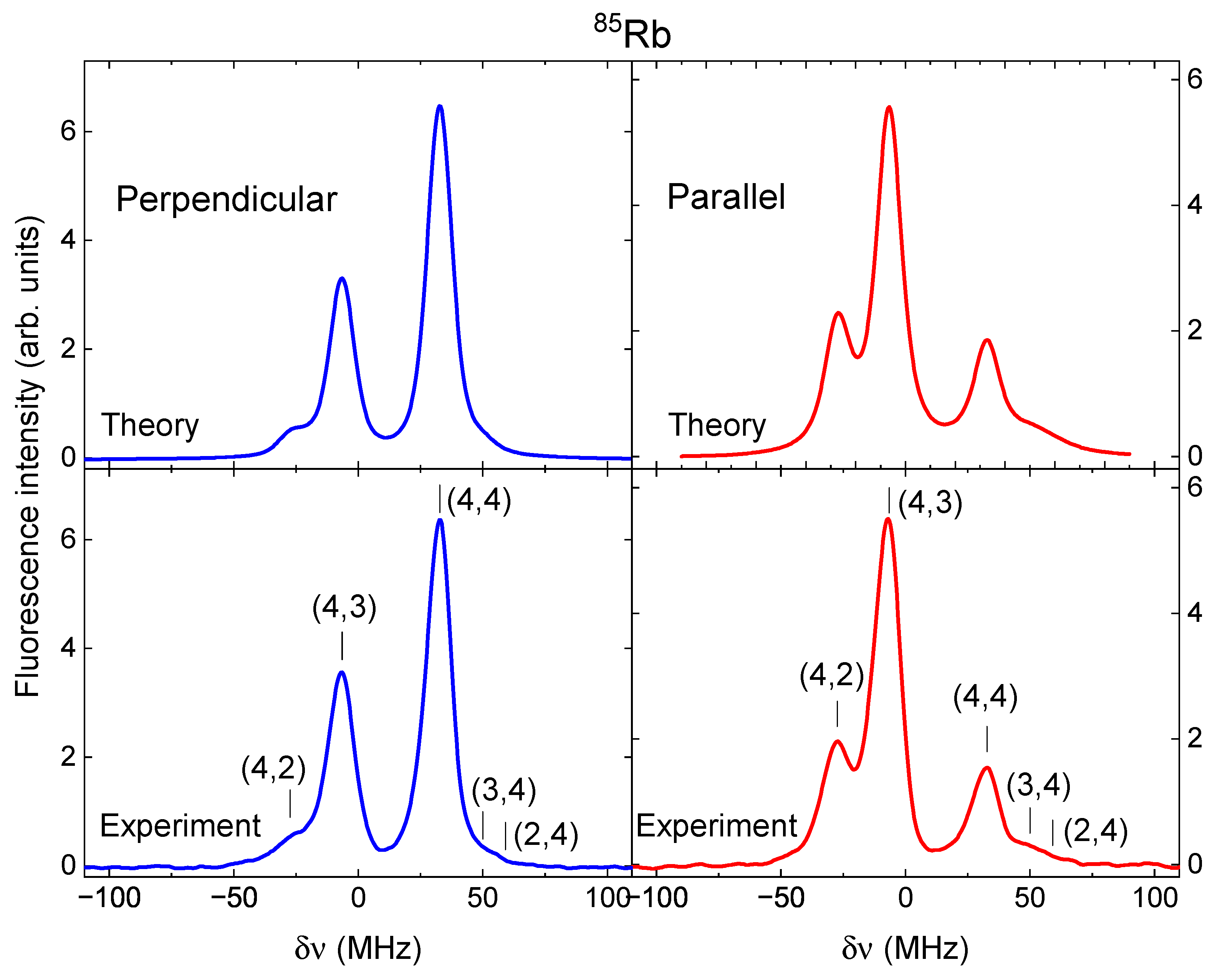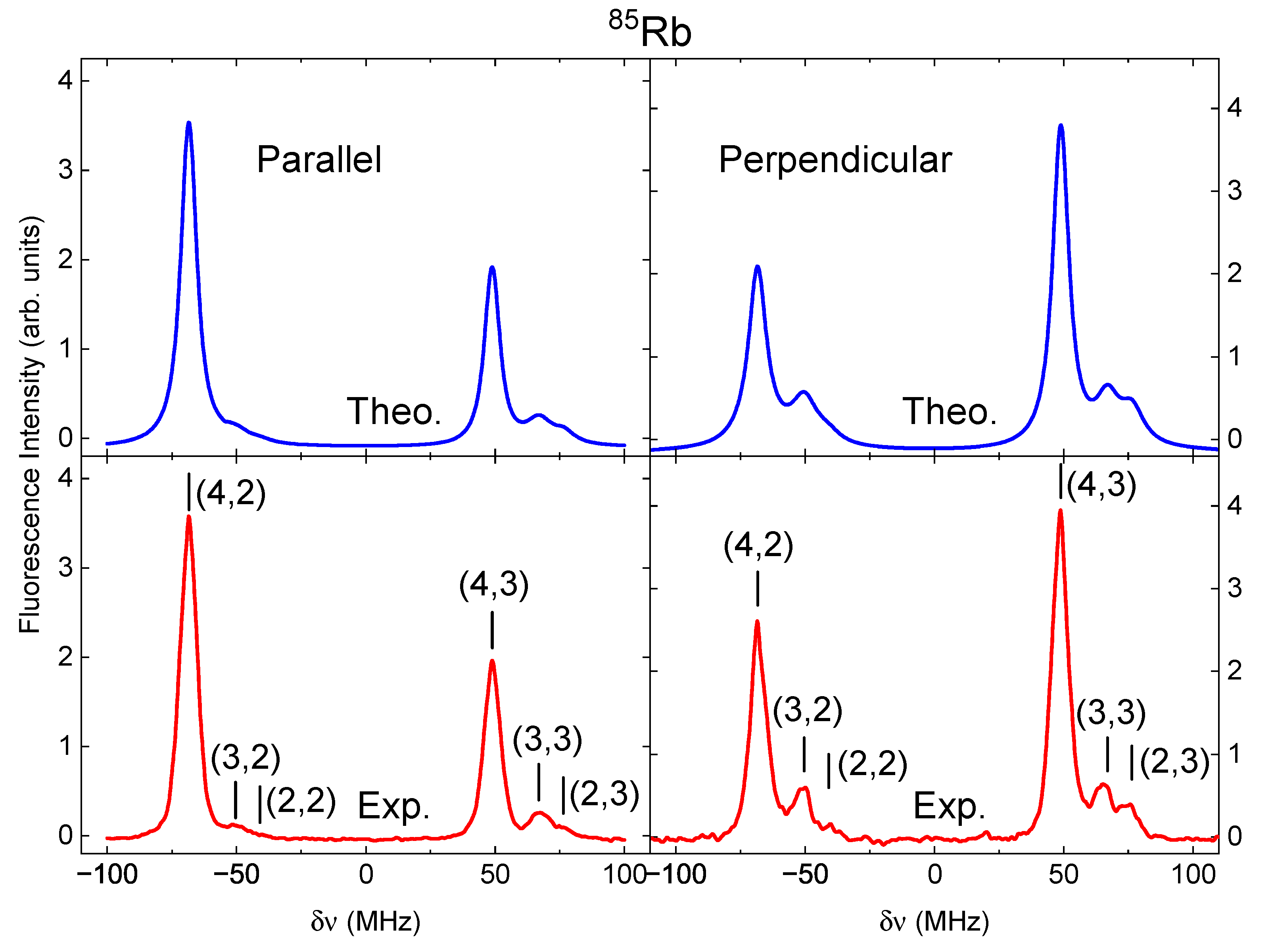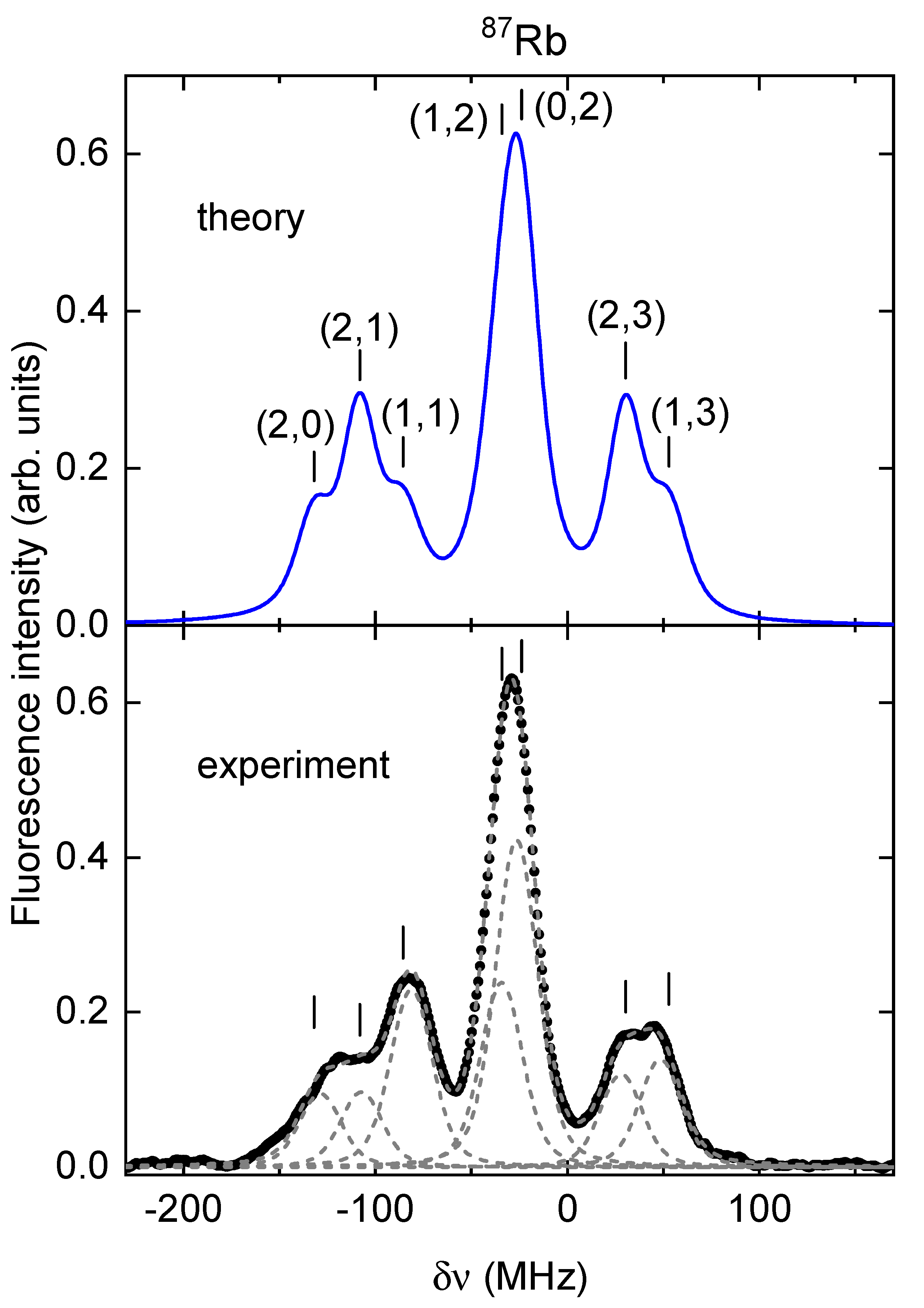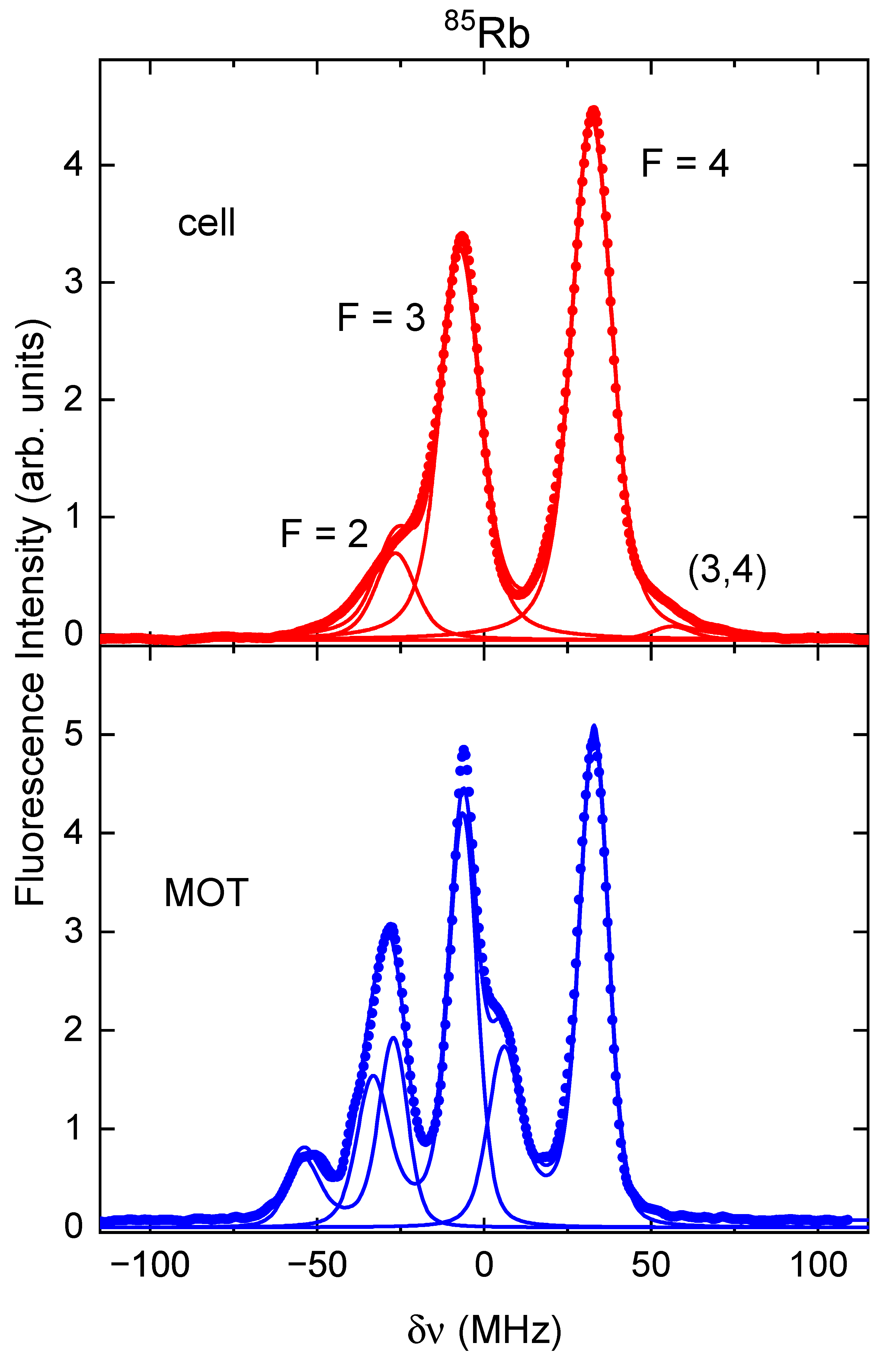1. Introduction
Alkali atoms, with a simple electronic structure, are naturally a good testing ground in the experimental and theoretical study of electromagnetic transitions beyond the electric dipole approximation. Examples of experiments to observe such transitions in room-temperature or hot vapors of alkali atoms include the study of s to d excitations [
1,
2,
3], and also of the relatively strong p to p transitions in rubidium [
4,
5,
6,
7,
8,
9]. There are also experiments in which electric dipole forbidden transitions were observed in cold atoms in magneto-optical traps [
10,
11,
12].
The purpose of this article is to present a review of the main results of the experiments and calculations carried out in our research group to study the
(
,
) electric quadrupole transition in atomic rubidium. To observe this transition, one has to have a significant atomic population in the
initial state, which is itself an excited state. A narrow bandwidth laser is used to prepare this population. A second laser is then tuned to excite the electric quadrupole transition. This forbidden transition was first reported in [
5], where it was shown that the hyperfine structure of the
state could be resolved, and also that optical pumping and selection of velocity effects determined the overall structure of the electric dipole forbidden spectra. A three-step description was also proposed, which takes advantage of the large disparity in intensities between the strong preparation step and the weak electric quadrupole excitation. The second article [
6] is a detailed study of the dependence of the electric quadrupole spectra on the relative polarization directions of the laser preparing the
initial state of the transition, and of the laser producing the forbidden transition. Results for the
transition are given in [
7]. A complete calculation was then presented in [
8] to explain in detail the use of the electric quadrupole transition as a probe of the Autler–Townes effect induced by the strong mixing of states produced by the preparation step. Finally, in [
9], a dynamic model that includes velocity-dependent terms in the rate equation approximation is used to reproduce the positions and intensities of the main transitions and also of the satellites that result from selection of velocity effects.
The structure of this review paper is the following: in
Section 2 the overall design of the experiments is shown. The experimental setup is presented in
Section 3. Details of the three-step description and of the relationship between the polarization directions and the selection rules are described in
Section 4. Examples of experimental spectra and their comparison with the results of the model are shown in
Section 5. Here, recent results of spectra obtained in a magneto-optical trap serve to compare the use of the electric quadrupole transition as an ideal probe of the Autler–Townes effect. Finally, the overall conclusions are given in
Section 6.
2. The (, )
Electric Quadrupole Transitions in Rubidium
The energy levels relevant to this work are shown in
Figure 1. The electric dipole forbidden transition occurs between the
and the
fine structure states. The initial state of this transition is also the first excited state of the atom, so it is necessary to excite a significant population of atoms from the ground state into this state. The electric quadrupole transition occurs at 911 nm to excite to the
state, and at 917 nm if one wants to reach the
state. Production of the forbidden transition is probed by the detection of the 420(422) nm photons that result from the direct electric dipole decay of the
state into the ground state.
A three-level atom description of the interaction between the two radiation fields and an atom is used as the starting point of the calculations [
5,
6]. This model considers that the coupling between the
and
states by the forbidden transition is very weak. Therefore, the intensity of the preparation stage will determine the regime that must be used in the calculation. For low intensities the three-level system predicts single decay lines for each
hyperfine state, while for stronger coupling, the Autler–Townes effect takes place [
13], and the fluorescence lines split into doublets.
The bandwidths of the lasers used are narrow enough to allow resolution of the hyperfine structure of all three
,
and
fine structure states. Therefore, in
Figure 1b their hyperfine structure is presented. For the experiments with room-temperature atoms [
5,
6,
7,
8,
9], the preparation laser selects the value of the total angular momentum
of the ground state. The hyperfine structure and the selection rules for electric dipole transitions determine the characteristics of the
preparation step. In particular, important optical pumping effects, combined with the selection of velocities present in the interaction with room-temperature atoms, determine the
hyperfine states that are significantly populated, and thus determine the structure of the electric quadrupole transition spectra. A distinction must be made in the preparation step between the cyclic transition (indicated by a continuous arrow), and the other non-cyclic transitions (an example shown by the dashed arrows). In the cyclic transition decay occurs only into the same hyperfine ground state; while in the non-cyclic transitions, decay to the other ground hyperfine (dark) state also occurs. Therefore, with the cyclic transition, optical pumping redistributes populations among the different magnetic sublevels, while for non-cyclic transitions, optical pumping effects effectively remove atoms from the preparation step.
5. Results and Discussion
Figure 3 shows an example of fluorescence spectra recorded when the preparation laser is locked to the
cyclic transition for atoms with a zero-velocity component. The frequency of the 911 nm laser is scanned across the
electric quadrupole transition region. The left-hand panel shows the spectra when the linear polarization of the 911 nm laser is perpendicular to the polarization of the preparation laser. The right-hand panel corresponds to parallel polarizations. The peaks in the spectra are labeled by
, where
is the total angular momentum of the
initial hyperfine state, and
is the total angular momentum of the
final state of the electric quadrupole transition. Three peaks are readily identified in both spectra, which result from the excitation of the zero-velocity group of atoms (
) into the
, 2 and 3 excited states. However, there are three more peaks that result from excitation of the group of atoms that is prepared in the
state. These correspond to the electric quadrupole transitions
, 1 and 3. Note the absence of the peak corresponding to the
, which is not an allowed electric quadrupole transition. This absence results as a consequence of the null value of the six-j symbol in
Table 1. These satellites are clearly present in the spectrum recorded with perpendicular polarizations. For parallel polarizations, only the
satellite line can be identified. In both spectra the
transition appears as a shoulder to the low-frequency side of the main
line. The remarkable differences in the relative intensities of the dominant peaks when the electric quadrupole transition is produced by linearly polarized light with the electric field vector parallel or perpendicular to the quantization axis is a direct manifestation of the selection rules over the magnetic quantum numbers [
6]. For parallel polarizations, the electric quadrupole transitions must obey
, while for perpendicular polarization, the selection rule is
. The top panels in
Figure 3 show the spectra obtained by solving the set of velocity-dependent rate equations [
9]. The excellent agreement between experiment and theory shows that the three-step description accurately reproduces the position, relative intensity and polarization dependence of the main lines and also of the velocity-dependent satellites.
A similar set of spectra, obtained for
Rb, is shown in
Figure 4. The preparation laser was locked to the
cyclic transition for the group of atoms with a zero-velocity component. The spectra are dominated by the three peaks resulting from the electric quadrupole excitations from this
hyperfine state into
, 3 and 4. Once again, satellite lines appear, but now on the high-frequency side of the spectra. In this case, these satellites result from electric quadrupole transitions originating from the
and 2 hyperfine states into the
state. The relative intensity of these satellites is not as large, compared to
Rb, because for these spectra the power of the preparation laser was about a factor of three larger than the one used for the spectra in
Figure 3. The reduction of the relative intensity results from optical pumping of atoms out of the
and 3 intermediate states [
9]. The calculation includes this effect, and therefore produces spectra that are in very good agreement with the experiment.
Figure 5 shows spectra for the transition to the other fine structure state of the
manifold in
Rb, namely, the
electric quadrupole transition [
7]. Spectra obtained with parallel and perpendicular polarizations are presented in each panel. Here, the
hyperfine structure consists of the
and
states. One can identify six lines, resulting from electric quadrupole transitions from each of the
, 3 and 4 hyperfine states prepared by selection of velocities. Once again, the main lines result when the preparation step produces the
cyclic transition. Sets of two satellite lines appear towards the high-frequency side of these two main lines. The satellites are better resolved in the spectrum with perpendicular polarizations. The results of the velocity-dependent rate equation calculations shown in the top panels [
9] are in very good agreement with the experimental data.
Electric quadrupole transitions can also be observed when the preparation laser is locked to the
low F cyclic transition. A spectrum showing these transitions in
Rb is shown in
Figure 6 [
9]. In this case, there is only one electric quadrupole transition from the
hyperfine state, namely, into the
state. However, the velocity-dependent calculation shows [
9] that the preparation laser efficiently populates the other
states. A fit of Voigt profiles with common widths allows the direct identification of seven lines in the experimental spectrum (bottom panel). The calculation also has seven lines, with the assignment shown in the top panel. In this case, the calculation does not reproduce the relative intensities of all the lines well but does show the presence of three separate groups of transitions. In the first group with three transitions, the experimental results show a stronger
transition while the calculation indicates that the
transition should be stronger. Both experiment and theory agree that the group in the center, with
and
transitions, should be the one with the largest intensity. Finally, the experimental spectrum has two lines of nearly equal intensity for the third group, and in this case the calculation results in a stronger
transition. It is important to notice the absence of the
line in this spectrum, which is forbidden as an electric quadrupole transition.
All
electric quadrupole spectra that were studied show a strong dependence on the polarization configuration of both 780 nm and 911 nm lasers [
6,
7]. The selection rules for electric quadrupole transitions over the magnetic quantum numbers, together with an anisotropic distribution of the populations
, are responsible for this behavior. As indicated in
Section 4, for relative directions between parallel and perpendicular one expects a
dependence on the angle between linear polarizations [
6].
Figure 6 of [
6] presents a detailed study of the angular distribution of the main line intensities for the
forbidden transition in
Rb. One can find a similar analysis for the
transition in
Rb in [
7]. The left panel of
Figure 7 shows the angular distribution of the intensities of the three main peaks of the
transition in
Rb. The discrete symbols are the results of the intensities of the
, 2 and 3 main lines, normalized so that the sum of intensities is equal to one. The dashed lines give the results of fits to functions of the form
4 where
are free parameters. The continuous lines are the results of using the three-step description to calculate
and
. These parameters can be calculated using the populations
shown in the right-hand panel that were calculated by solving the rate equations. These continuous lines are the result of an ab initio calculation, and therefore contain no free parameters. The small discrepancies between the ab initio calculation and the results of the fits can be explained if one considers imperfections in the degree of polarization of each of the two lasers used in the experiment, and also for the uncertainty in the determination of the zero in the angular scale. The angular dependence was also used to test the theoretical results for the production of the electric quadrupole transition with scalar paraxial Bessel beams, in the sense that no significant difference was found with the angular distribution obtained with a Gaussian beam. In order to excite the electric quadrupole transition with a non-paraxial beam, the experimental setup of
Figure 2 has to be modified. The design and implementation of such an experiment are left for future studies.
The electric quadrupole transitions that are reviewed here are seven orders of magnitude weaker than the
electric dipole transition. This inherent weakness makes them ideal probes of the Autler–Townes splitting induced by the strong preparation transition. This is studied in detail in [
8], where it is shown that a simple three-level model is not adequate to describe the dependence of the Autler–Townes profile intensities on the preparation laser intensity. Velocity distribution effects, when added to the presence of alternative decay routes from the
state, provided the ingredients needed for an adequate description of the formation of the Autler–Townes doublets [
8].
The electric quadrupole transition can also be observed in cold atoms in a magneto-optical trap (MOT) in fully operational conditions. In this case, the MOT trapping and repumping beams are used in the preparation step, and a single 911 nm beam produces the forbidden transition. The intensity of these preparation beams is large enough to produce an Autler–Townes splitting in the fluorescence spectra.
Figure 8 shows the comparison between a spectrum recorded in a MOT and that obtained in a cell. These experimental results show the
electric quadrupole transition in
Rb. For the cell spectrum, the laser intensity is large enough to ensure that the satellite lines do not contribute significantly, but are low enough to stay below the Autler–Townes regime. Furthermore, this cell spectrum was recorded with the linear polarization of the 911 nm laser making an angle of
, close enough to the
magic angle for which there is no contribution from the coefficient of the angular dependent term in Equation (
4). The spectrum obtained with the MOT in the bottom panel shows three sets of asymmetric Autler–Townes doublets, with the strongest component of each doublet aligned with each
transition. It is remarkable that the relative intensities of the three doublets closely resemble the intensity distribution at the magic angle observed in the top panel.
A similar comparison can be made with the
electric quadrupole transition for
Rb atoms in a MOT and in a cell. Sample spectra showing two stages of the Autler–Townes effect are shown in
Figure 9. The comparison is made for commensurate values of the Rabi frequency. These values are obtained directly from the spectra by fitting an Autler–Townes profile to each hyperfine line. The left panels indicate that for a Rabi frequency of about 4 MHz, the Autler–Townes doublet begins to appear. This occurs in both the cell and the MOT. At about twice this value of the Rabi frequency (right panels), the Autler–Townes doublets are clearly defined. The line profiles in the cell (top panel) are symmetric, indicating an effective zero-frequency detuning in the preparation step. The asymmetry in the MOT spectra (bottom panel) is caused by the red detuning of the trapping laser in the MOT. This detuning can be directly obtained from the AT profiles in the spectrum. The relative intensities of the
hyperfine lines in the MOT correspond more to a cell spectrum recorded at the magic angle.
